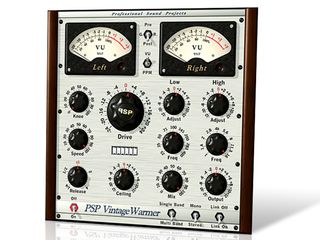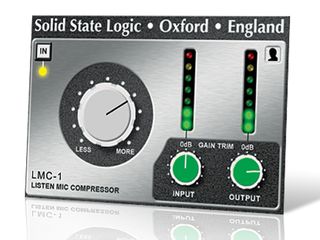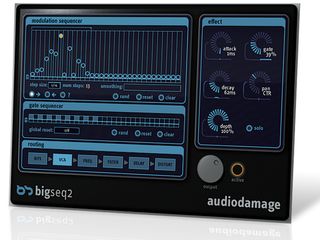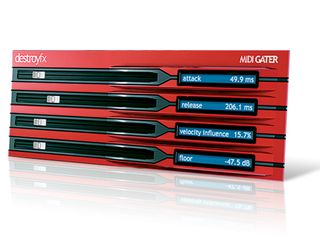Famed producer Tony Visconti (David Bowie, T-Rex) has been quoted as saying that "compression is the sound of rock 'n' roll". We wouldn't think of arguing with that statement - but we might also suggest that compression is not only the sound of rock 'n' roll, but of all popular musical genres.
For one, there are few (if any) radio stations that don't apply compression to all of their broadcast signals, though compression is already in place on virtually every track they play. Compression (together with its cousin, limiting) has become a ubiquitous effect, used even to a fault by professional recording and mastering engineers - and the reason for this often heavy-handed approach is because compression makes a mix sound louder.
Have you ever noticed that some of your commercial CDs sound louder than others, even if the meters say it isn't so? That's because more compression has been applied to the 'louder' disc. It isn't really louder - it's just that the dynamic range has been reduced, making the quiet bits sound louder and the loud bits sound quieter, allowing the mastering engineer to bring up the volume of the whole shebang. This has actually become a bit of a controversial issue in the music community, but we'll talk about that a little later on.
"Clearly, an understanding of dynamics processing is crucial if you're going to create any sort of music."
If, as Mr Visconti asserts, compression is the sound of rock, then gating is nearly as important to dance music. Gates were initially created to reduce noise by reducing the gain of any signal that falls below a specified level. Such an effect is also called an expander. Due to a neat trick known as sidechaining, clever producers can use gates to create rhythmic control over the volume level of one signal based on the dynamics of another. The results are something like the effect of riding the volume or mute controls of a mixer in time to the rhythm of another track.
This effect has become so pervasive in today's music production scene that dedicated plug-ins have been developed to provide it. It is also included in many modern synthesisers. It's even been given a name: the trance gate
Clearly, an understanding of dynamics processing is crucial if you're going to create any sort of music, and especially if your chosen genres run to the most current styles. With that in mind, let's take a closer look…
Compression
Compressors are also commonly applied to individual tracks. Think about some of your favourite vocal recordings. Do the vocals range from a whisper to a scream in what is clearly one contiguous take? It's more than likely that they do - yet you can still hear every word quite clearly. How is this achieved?
Well, sometimes it's nothing more than good microphone technique. If a vocalist knows to back off of the mic when he or she belts it out, then little or no compression may be necessary. If the singer is all over the place, however, a compressor can help tame the dynamics, bringing the quiet bits up while at the same time reducing the loud parts.
Compression isn't just used for fixing up errant vocals - it's often applied to drums, too. It can be a great help with the already difficult task of getting a good drum mix, but can also make for a pretty cool effect in its own right. We've all hear the weird 'pumping' sound on some rock drum recordings - well, that sound is produced by the compressor.
"A compressor can help tame the dynamics, bringing the quiet bits up while at the same time reducing the loud parts."
The roles of the compressor are many and varied. Obviously, you're going to need to delve into the world of compression if you want to get that professional sound.
So what exactly is a compressor? As we've intimated, it's essentially a means by which dynamics are automatically reduced. It is the 'black box' equivalent of keeping your finger on the volume knob and turning the volume down when the signal gets too loud and up when it becomes too quiet.
How does the compressor know when to adjust the gain? Well, it has a threshold control that determines when the compression circuit should kick in. The amount of gain reduction to be applied is usually given as a ratio, such as 8:1. In this example, this means that if the incoming signal is 8dB over the threshold setting, it will be brought down to 1 dB over when it comes out of the other end. That's 7dB of signal reduction.
As you can guess, it can be quite easy to reduce the gain to little more than a peep. Therefore, most compressors have some sort of make-up gain control that brings the overall effected output signal back up to a more respectable level. Additionally, many compressors provide attack and release controls. These are used to decrease the response of the compression circuit, making the signal sound a little bit smoother and more natural.
You will likely encounter multiband compressors at some point. These have become quite popular in recent years, and for good reason. You see, they allow you to single out individual frequency ranges and compress them individually. These devices, like limiters, are often applied at the mastering stages and are the ballistic missiles of the so-called 'loudness war', a name given to the recent preference among record company bigwigs for over-compressing at the mastering stage.
The loudness war
A lot of ink has been spilt over the loudness war. As we suggested earlier on, compression and limiting are being applied willy-nilly to nearly every final mix that hits a studio (or even before), without regard for the track's integrity.
Certainly, some compression may be warranted, depending on the track. For instance, when faced with a collection of individual songs, a mastering engineer will need to adjust the overall volume and possibly the dynamic range in order to wrangle those tracks into a cohesive album. It may also need to be applied if a song is to be released on vinyl, which has a limited tolerance for extreme dynamics.
Nevertheless, compression is usually applied these days just to bring the perceived level of a track up to ear-shattering levels. PR guys like it because the track gains immediate attention, but many musicians, recordists and mastering engineers rightly take umbrage with the fact that their hard work is being compromised.
Ironically, this reduction in dynamism often has the opposite effect that the producers and PR men are hoping to achieve - over-compressed mixes tend to produce ear fatigue and do not invite repeated listening.
Limiters and expanders
If you're new to music production, you might be confused by the difference between compressors and limiters. Limiters are essentially just compressors, though some engineers see limiting as a separate function. Limiters tend to have very high ratios and fast attacks. Likewise, expanders are really compressors in reverse. They might reduce the gain of a signal below the threshold or boost the gain of a signal that overshoots it, thereby expanding the dynamic range of the material.
This is the same process that's used to create a noise gate. Say you've recorded a killer guitar track, but it has a lot of ambient noise that becomes apparent whenever the guitar bits are silent. You could edit all of this noise out in your DAW, but that can be a very tedious procedure.
Instead, you might consider an expander, with the threshold set just above the level of the noise but well below that of the guitar. Every time the level drops below the threshold, the expander will kick in, reducing its level (and that of the noise) even more. If it reduces the signal to complete silence, the process is known as gating.
Sidechaining and gates
As we've mentioned, many dynamics processors also allow sidechaining, which allows a second signal to determine when the process should kick in. Sidechain compression is useful for special effects or for more utilitarian functions such as de-essing, and for the gating effects described above.
Because gates are simply dynamics processors, they, like expanders and limiters, share many of the same controls and functions, such as threshold, attack and release settings. In the case of a gate, the attack and release will determine how smoothly the gate opens and closes. Fast attacks and releases will result in a more abrupt sound, while longer settings will allow the sound to fade in every time the threshold is exceeded by the modulating signal and fade out gradually when that signal dips below the threshold.
Sidechain compression is a crucial effect in modern genres, particularly dance music, as dynamic volume ducking is required to get mixes sounding as loud and pumping as possible. It has become a familiar stylistic tool in many forms of dance since Eric Prydz introduced it to the mainstream with Call On Me.
While we're on the subject of the cool effects that can be achieved with sidechaining, we should also mention the envelope follower. This is closely related to the trance gate effect. The term 'envelope follower' may bring to mind the classic auto-wah effect, a technique wherein threshold detection is used to trigger an envelope generator that is, in turn, used to modulate a filter. However, the envelope follower itself makes up only the first part of that process, and does not necessarily need to be tied to the filter. It can, in fact, control volume or any other parameter, assuming the developer or manufacturer has provided the means to do so.
"Sidechain compression is a crucial effect in modern genres, particularly dance music, as dynamic volume ducking is required to get mixes sounding as loud and pumping as possible."
Savvy readers will note the similarity between such processes and those used in vocoders. Vocoders can be created by splitting an incoming signal into various frequency bands and tracking the dynamics of those bands, which are then imparted onto a new sound. We won't go into a detailed discussion of vocoders here, but suffice it to say that they clearly have their roots in dynamics processing.
Though these techniques and devices were originally intended as corrective tools, they can be cranked up to ridiculous levels, sometimes with surprisingly effective results. In general, however, we urge you to use discretion whenever you apply any dynamics processing, whether to individual tracks or entire mixes.
One tip: you should never apply compression to your final mix if that mix is to be mastered later. Even if it isn't, keep an uncompressed mix as a safety net. Used with skill and taste, dynamics processors can bring your tracks to life, imparting a professional clarity and cohesiveness to a mix or providing a range of crowd-pleasing special effects.
NEXT: Four cool compressors
Four cool compressors

PSP Audio Vintage Warmer, $149
It's a bit of an oldie, but Vintage Warmer still sounds terrific even when held up to newer plug-ins. Multiband compression and brickwall limiting are on offer, as well as PSP Audio's gloriously retro sound, thanks to the included tape saturation simulation. It's fairly easy to use, though it isn't exactly spartan in design. A once and future winner, this one.

Cytomic The Glue, $99
Here we have another classic vintage compressor, meticulously modelled and given a few extra features. Combining the best of the E and G series SSL 4000 bus compressors, The Glue sports a super-fast attack time and a range knob to control the amount of compression applied. There are loads of other controls, plus sidechaining to boot.

FabFilter Pro-C, £129
If there's anyone who knows how to wrangle a classic hardware sound from zeros and ones, it's FabFilter. Its Pro-C compressor earned rave reviews when it was released, and with Clean, Classic, and Opto modes on hand, this dynamic dynamo can handle anything you throw at it. Better still, it's actually easy to use and comes with an excellent collection of presets.

Solid State Logic LMC-1, Free
This is an emulation of the Listen Mic Compressor, modelled from the famous E-Series consoles. The original was meant merely as a means to prevent overloading the console's talk-back mic, but was made famous when it was used to record Phil Collins' drums on Peter Gabriel's Intruder. This brief flash of inspiration shaped the sound of the following decade.
Download Solid State Logic LMC-1
NEXT: Four great gates
Four great gates

Audio Damage BigSeq2, $49
The original BigSeq featured a pretty cool gate effect, but the second version blows the lid off. It's got ten effects that are arranged in six 'blocks', each with its own step sequencer, modulation sequencer and timing. The idea is to sequence the gate effects and modulation for some outre sounds. As always with Audio Damage, it's anything but run-of-the-mill.
Read Audio Damage BigSeq2 review

AraldFX StormGate, Free
StormGate offers a different approach to gating. Instead of relying on a sidechained signal to trigger the process, it allows users to create dynamic patterns by drawing shapes into a large display area. These gate patterns can be looped and synchronised to the host's tempo. There's even support for swing to give your rhythms even more vibe.

AraldFX StormGate, Free
This slippery little morsel is included in The Fish Fillets suite, along with the cool Blockfish compressor and Spitfish de-esser. Here, though, the focus is on expansion and gating. Stereo support is on tap, and you can tweak the attack and release settings. Use Floorfish to block out noise or to expand the incoming signal - it's a must-have utility for any plug-in folder.
Download digitalfishphones Fish Fillets

Destroy FX MIDI Gater, Free
Taking the gating idea far beyond its roots, this plug-in is more like an instrument in that it responds to incoming MIDI notes. The idea here is MIDI-controlled gating, but with a twist - you see, MIDI Gater is polyphonic. A new copy of the incoming signal is produced for every incoming MIDI note, and each copy responds to velocity. Strange stuff, but good fun!

